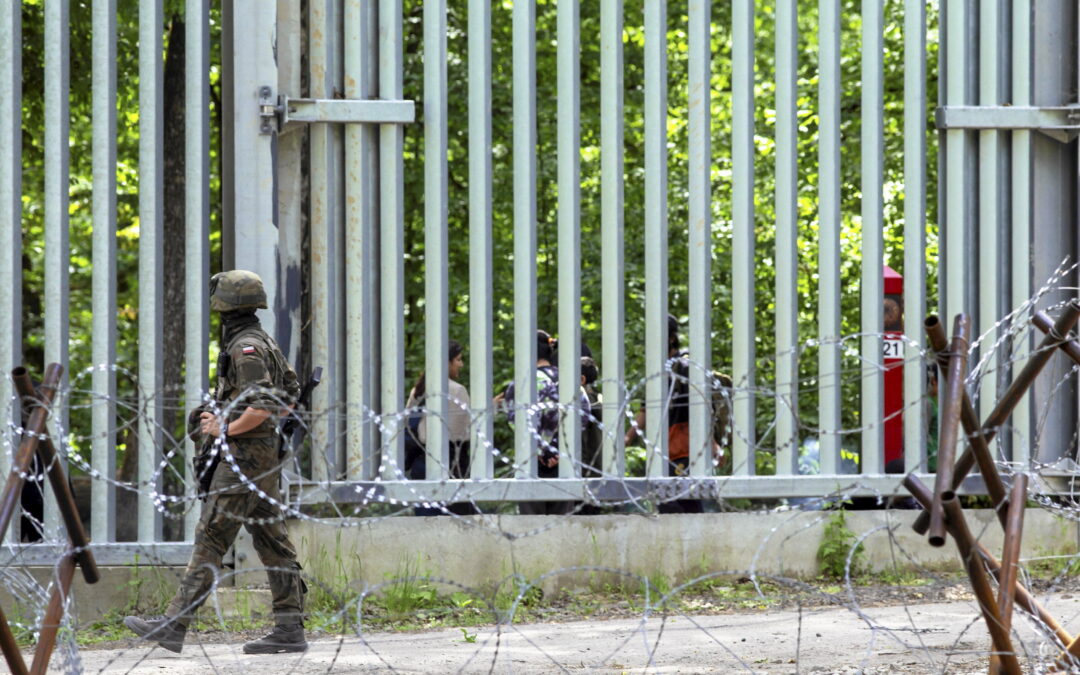By Michał Piekarski
On 29 May, following the stabbing of a Polish soldier (who later died from his wounds) by a migrant trying to cross into Poland from Belarus, Prime Minister Donald Tusk announced plans to introduce an exclusion zone on parts of the border.
The relevant regulation was signed today, 12 June, and will go into force tomorrow. The exclusion zone will ban unauthorised people from entering within 200 metres of the Polish side of the border in some places and up to two kilometres in others.
An exclusion zone will be introduced along part of Poland’s border with Belarus on Thursday in response to the intensifying migration crisis.
Unauthorised people will not be allowed to be within 200m of the border in some places, and up to 2km in others https://t.co/TrJabL4N2x
— Notes from Poland 🇵🇱 (@notesfrompoland) June 10, 2024
The new measures resemble previous, highly controversial ones introduced by the former Law and Justice (PiS) government in 2021 in response to the start of the migration crisis at the Belarus border. At the time, the opposition – which included members of Poland’s current ruling coalition – criticised the government’s actions.
Michał Piekarski, a scholar specialising in national security and hybrid warfare at the University of Wrocław, explains what has been happening at the border, if and how it differs from earlier stages of the crisis, and what the government’s new measures will mean in practice.
What has changed in the migration crisis on the Poland-Belarus border?
Since the beginning of spring, a growing number of migrants have attempted to cross into Poland from Belarus.
The Podlaski Border Guard Regional Unit (POSG) – which is responsible for monitoring and protecting most of the country’s border with Belarus – publishes regular statistical reports. It noted that in May this year there were 7,100 attempts to cross the border compared to 1,900 in the same month last year and just 913 in May 2022.
Alongside the increase in attempted crossings, new patterns of violence from some migrants have been documented. In previous years, this primarily comprised throwing sticks and stones, especially towards patrol cars. This year, knife attacks targeting Polish officers have been observed for the first time.
This has resulted in soldiers and police being wounded. One soldier, who was stabbed through the border fence while attempting to stop a group of migrants from forcing their way across, died from his injuries on 6 June. This is the first time that a Polish officer has been killed during the crisis.
A Polish soldier has died after being stabbed with a knife while trying to stop a group of migrants from forcing their way across the border from Belarus https://t.co/nH2gp3g5sT
— Notes from Poland 🇵🇱 (@notesfrompoland) June 6, 2024
This month, Polish defence minister Władysław Kosiniak-Kamysz claimed that, while in previous years the Belarusian authorities directed more women and children to the border, now “specialised groups of thugs” who attack officers are being sent.
Foreign minister Radosław Sikorski also claimed in an interview with the Gazeta Wyborcza daily that 90% of people recently detained while trying to cross the border have Russian visas and are being sent from Moscow via Minsk to destabilise the European Union.
However, at the time of writing no data have been published to support either minister’s claim.
Why has the situation on the border changed?
The growing influx of migrants, encouraged by the Belarusian and Russian authorities, may be a deliberate attempt to put Tusk’s government in a difficult position where there are few positive political outcomes.
When implementing its strict border control regime, Poland’s previous national-conservative PiS government faced criticism for its policy of “pushing back” migrants and asylum seekers and for prohibiting NGOs, media and other individuals from visiting the border.
Poland’s new ruling government is a coalition formed in large part by liberal-centrist parties. While in opposition, such parties typically placed emphasis on democratic values (such as freedom of the press) and human rights. The changing situation on the border is thus particularly challenging.
Amid a worsening crisis at the Belarus border, Polish foreign minister @sikorskiradek says that, as a former refugee, he sympathises with migrants
But he adds that Poland must defend its border from Russia and Belarus' use of migrants in a "hybrid attack" https://t.co/0py17HBI1j
— Notes from Poland 🇵🇱 (@notesfrompoland) June 4, 2024
By taking a tough stance, the government can be accused of continuing PiS-enacted border policy and not representing real change. Internationally, Poland can be portrayed as a state that is neglecting or breaching human rights
Conversely, by relaxing existing measures the government can be seen as “soft” and neglecting national security. It also faces pressure from countries further west – especially Germany, which is the primary end target of the migrants – to prevent crossings.
Neither result is desirable.
Second is the issue of preparedness and resources at the border, which may have been exploited by Minsk and Moscow to destabilise Poland.
The stabbing of officers has raised questions about the adequacy of the rules of engagement set by Polish law, the orders issued to soldiers, and the quality and accessibility of protection equipment.
This can be seen in the controversy surrounding a recent report. News website Onet detailed the detention of three soldiers by military police several weeks earlier for firing warning shots at a group of migrants attempting to enter Poland illegally. Two of the soldiers were later charged with using excessive force.
Polish police serving on the border with Belarus have been ordered to carry guns due to “growing aggression” from migrants.
Meanwhile, the speaker of parliament has defended the right of soldiers to "shoot at thugs who attack them" across the border https://t.co/WK7fiJ87ZF
— Notes from Poland 🇵🇱 (@notesfrompoland) June 7, 2024
Finally, the Polish-Belarusian border incorporates a large, forested area, including the primaeval Białowieża Forest. The spring and summer weather offers more favourable conditions for migrants to cross the border and then to move through the local area to meet smugglers who provide transport to Germany.
This, in turn, means that the actors controlling and profiting from the crisis – smugglers, the Russian and Belarusian security services – have sought to increase the flow of migrants.
How is the Polish government responding to the new situation on the border?
The government has decided to follow a similar path to PiS and strengthen the border.
The existing border fence built under the former government is composed of numerous vertical aluminium beams and razor wire. It is easy to penetrate – basic tools can be used to cut through the fence and it can be crossed at unprotected segments (e.g. next to rivers and swamps).
The current government will upgrade the existing structure. At the most basic level, horizontal beams will be added so that it is more difficult to damage.
In addition, the existing officers stationed at the border will be reinforced by an unknown number of military personnel and equipment. Riot police, armed with firearms alongside their regular batons, shields and tear gas, will also be deployed.
Donald Tusk has pledged further fortification of the border with Belarus, where Poland is facing a "hybrid war of illegal migration”.
The government's approach has been criticised by Agnieszka Holland, who says it is continuing previous "inhuman" policies https://t.co/DDmf43jEF3
— Notes from Poland 🇵🇱 (@notesfrompoland) May 13, 2024
The most significant measure is the reintroduction of the exclusion zone around the Białowieża Forest. This is possible under the Border Protection Act, which allows the interior minister, for reasons of security and public order, to implement a temporary exclusion zone on areas adjacent to the Polish border.
The exclusion zone is a restricted area that can only be entered by the emergency and uniformed services, or those who live, work, own a property, attend school or attend church in the zone. All other individuals – including journalists – must apply to the border guard for a special pass to enter.
In May, the government announced the “East Shield” military project to prepare the eastern border for potential military aggression. This may also make the border harder to cross, however its implementation will take a number of years.
What impact will the new measures have on the migration crisis?
The deployment of additional soldiers and police may lead to more frequent patrols and quicker responses to attempted border crossings as well as instances of violence. However, the entire border is 418 kilometres long and it will still be difficult to monitor and protect all of it.
The exclusion zone will reduce the movement of smugglers on the Polish side of the border, who would need to recruit local residents to work with them or instruct migrants to travel further into Poland before being collected. This may discourage some migrants from attempting to enter the EU via this route.
Does the Polish government face opposition to its plans?
Currently there is controversy surrounding the exclusion zone. The Helsinki Foundation for Human Rights and NGOs that assist and advocate for migrants, such as Border Group (Grupa Granica), have criticised the plans.
They suggested that the provision in the Border Protection Act that allows exclusion zones to be established may be unconstitutional. They also cited limitations on freedom of the press and difficulties in providing humanitarian aid as unacceptable consequences of limited access to the zone.
The exclusion zone may also have a negative impact on the local economy. Limited access to Białowieża Forest and increased police presence could reduce tourism in the region, impacting tour guides as well as the hospitality and gastronomy sectors.
However, according to the interior ministry, the zone will not include tourist routes and, following consultation with local authorities and businesses, has been limited to “a necessary minimum”.
How might Belarus and Russia respond to the new measures?
The Belarusian and Russian authorities will attempt to test every new element of border policy. They will use any successful attempts at crossing the exclusion zone as an example of the inefficacy of Polish border protection measures. Yet at the same time, the tough new policies can be exploited to portray Poland as violating human rights.
Further provocations at the border – violent or otherwise – may be used to perpetuate such narratives.

Notes from Poland is run by a small editorial team and published by an independent, non-profit foundation that is funded through donations from our readers. We cannot do what we do without your support.
Main image credit: Agnieszka Sadowska/ Agencja Wyborcza.pl




















